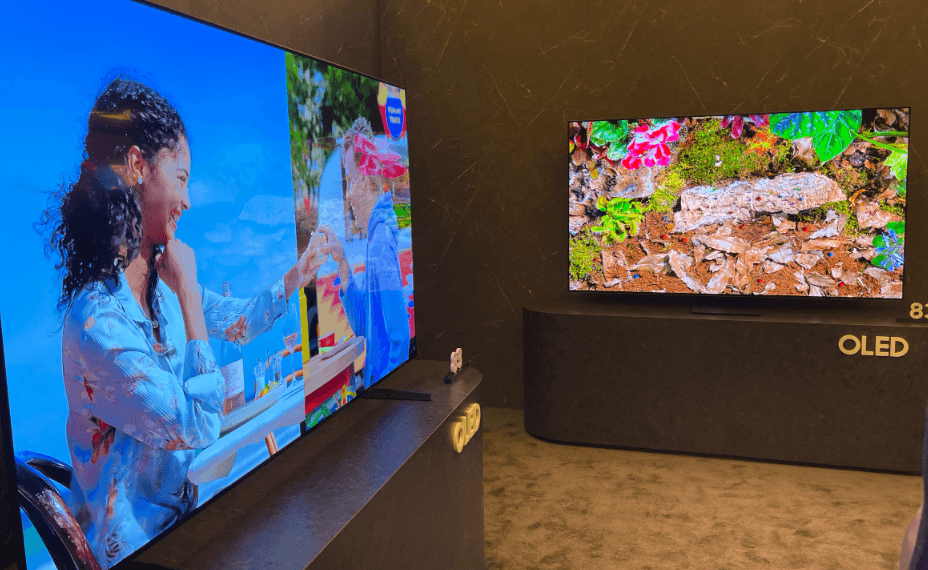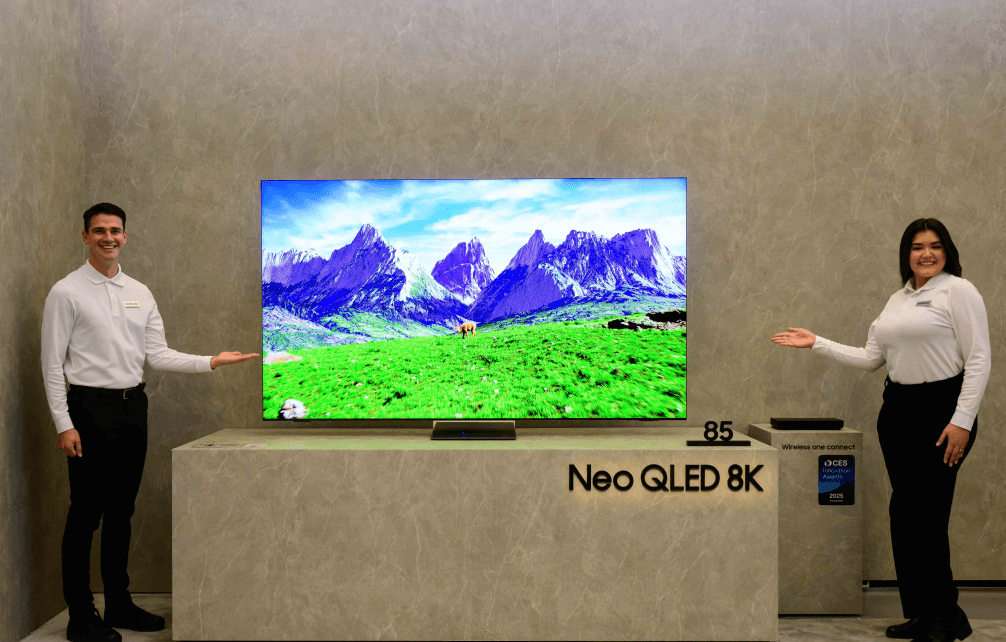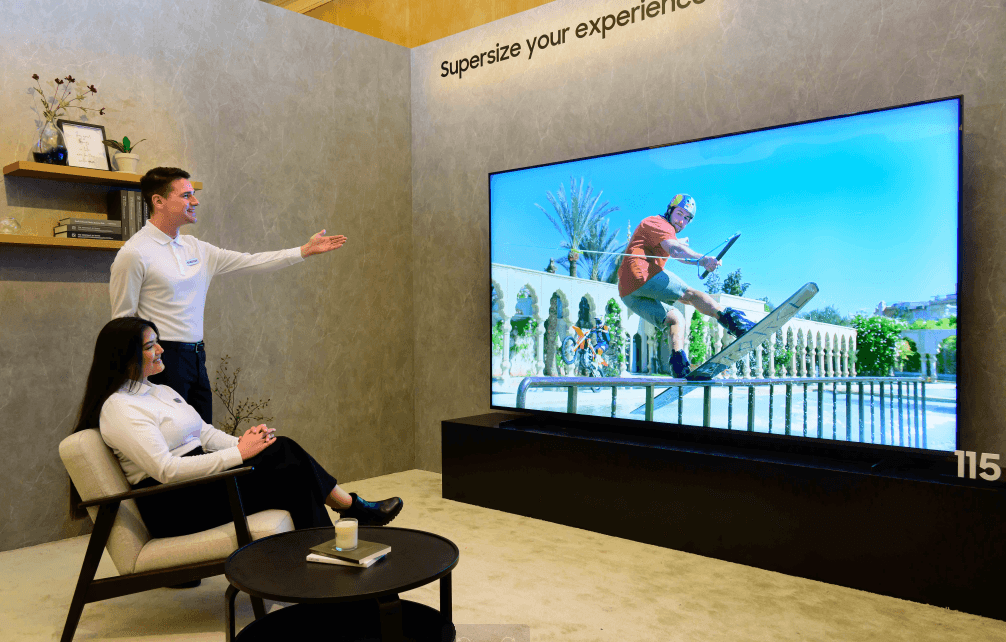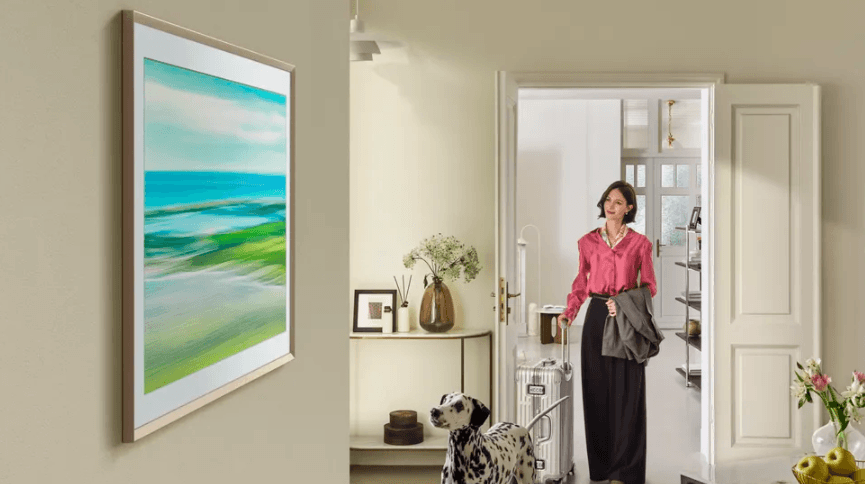
Samsung Electronics took to the stage at CES 2025 to reveal its latest advancements in TV technology, announcing new OLED models that promise to be brighter than ever before, as well as its largest-ever Neo QLED televisions.
The new OLED models include the Samsung S95F, S90F and S85F, and for the first time they’re all available in a maximum size of 83-inches.
The flagship S95F is the successor to Samsung’s best television from last year, the S95D OLED TV, and like the model it replaces, it will also sport a matte panel that helps to reduce onscreen reflections. But unlike last year’s version, it’s available in a bigger size, with an 83-inch model surpassing last year’s largest 77-inch version.
Where it gets confusing is that it seems that the S95F OLED TV will be subject to the company’s headscratching “panel lottery”. In other words, consumers might not know if they’re getting one of Samsung Display’s QD-OLED panels, or instead, a WOLED panel made by Samsung’s eternal rival LG Display.
FlatPanels HD says the 83-inch S95F TV it saw at CES was definitely equipped with a WOLED panel rather than QD-OLED, due to the subpixel layout. That’s to be expected as, currently, Samsung Display’s biggest QD-OLED panels only go up to 77-inches. Consumers who opt for a smaller size, however, will probably be getting one of Samsung’s own displays.
Adding to the confusion is that rumours persist that Samsung Display is actually planning to announce an 83-inch QD-OLED panel soon, though that has not been confirmed. If it does opt to make larger QD-OLED panels, then we’d imagine that they’ll almost certainly be integrated with at least some S95F OLED models, though it’s impossible to say which regions will get them.
Last year, the confusion was only restricted to Samsung’s midtier OLED TV, the S90D, rather than the S95D that exclusively used QD-OLED panels. And it’s likely that the panel lottery will once again afflict the S90F models, though if you buy a lower-end S85F TV, you can be pretty sure it will be using a WOLED panel, not QD-OLED.

Now that’s cleared up, we can take a look at what’s new for the S95F apart from the confusion. According to Samsung, it will be brighter than ever, with the company claiming that it’s new panel can reach up to 4,000 nits brightness.
HDTVTest chief reviewer Vincent Teoh got a chance to get up close and has confirmed that the S95F hits almost 400 nits at full screen, which appears to confirm those claims are truthful. You can learn more about it in this video:
Other updates include faster refresh rates, with the S95F supporting a 165Hz refresh rate, thanks in part to its new NQ4 AI Gen3 video processor
The S95F, S90F and S85F TVs will be available in sizes ranging from 42-inches to 83-inches, though the 42-inch version will be restricted to select markets.

For those who need to get their hands on an 8K TV, Samsung has just unveiled its latest QN900 Series Neo-QLED television, and there’s not one, but two models to choose from with the QN990F and QN900F set to go on sale later this year.
The QN990F will come in a fairly humongous 97-inch size and feature Samsung’s innovative One Connect Box for wireless connectivity, similar to LG’s M5 OLED TV, which has a “Zero Connect Box” instead. It appears that the new 8K models will both use last year’s chipset, the NQ8 AI Gen3 processor that debuted in the 2024 QN900D 8K TV, but the company promises some big improvements in performance and AI-powered functionality.
If 97-inches isn’t big enough to satisfy your urges, then the new QN90F 4K Mini-LED TV maxes out at a staggering 115-inches, bringing Samsung into competition with Chinese brands like Hisense and TCL, which have pioneered the trend of XXL TVs that go beyond 100-inches in size.

The Samsung QN90F is the company’s flagship 4K TV this year and it comes with a new ‘Supersize Picture Enhancer’ to help blow up those images to such enormous sizes without compromising on quality. The Neo QLED display will support 165Hz refresh rates, matching the S95F OLED TV, and it will also have the same matte finish as that model, helping to minimise any distractions caused by the reflection of ambient light.
Just below the QN90F sits the QN80F, which is a step-down model that’s limited to a mere 100-inches at the upper end, with various smaller sizes also available. Unlike the QN90F, it won’t have the matte display.
Samsung said it’s also updating its popular The Frame television, one of its most iconic TVs that famously doubles as a work of art when not being used to watch films or TV shows.

This year’s model is known as The Frame Pro, and it’s the first of its kind to adopt a higher-end Neo QLED display, rather than a regular LCD display. It also adds the Once Connect Box, helping to improve the aesthetics by eliminating those pesky cables. It supports wireless connectivity at up to 144Hz, which makes The Frame suitable for console and PC gaming too.
Also on show at CES was the company’s newest projector, the Samsung Premiere 5, which is said to be the first “interactive triple-laser ultra-short-throw projector” on the market, making it possible for users to “engage directly with the screen". Details of what this actually means are slim, but we imagine it might support some novel interactive games of some description.
Finally, Samsung also talked up some new AI features under the "Samsung Vision" banner, including its enhanced AI Upscaling, Auto HDR Remastering, Adaptive Sound Pro, Colour Booster Pro and AI Mode technologies. Those are all pretty self-evident, except for the last one which helps to pick the best settings for whatever type of content is being displayed, Samsung said.
There’s also a new “Click to Search” function that can help if you see something on-screen, such as an actor you don’t know, a location, or even a tempting bowl of dessert that you’d like to try. Simply click on it, and Samsung’s AI assistant will perform an internet search and try to identify the said actor/location/dessert and tell you more about them/it.